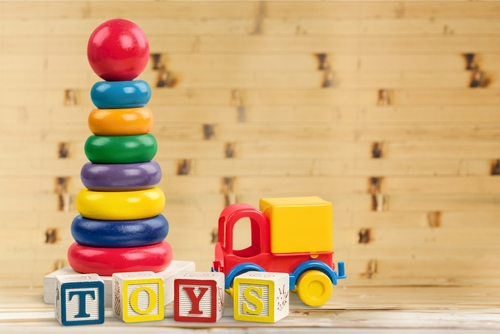
Parents should be concerned about protecting their children from exposure to lead. The reason for concern is there is no good level of lead in thе body according to the New York State Health Department.
Children’s Toys and Lead Paint
Most often, the danger present in toys comes from their lead paint. Ironically, although lead base paint was banned from residential use by the U.S. Consumer Products Safety Commission (CPSC) in 1978, many children’s toys, particularly those made in China, are found to contain levels of lead in excess of that allowed.
Lead in paint resists moisture, increases durability, speeds drying, and allows the pain to retain a fresh appearance, factors which presumably account for its persisted use despite its known toxicity. Parents can help keep their children safe by regularly checking recall lists to see іf their households have any hazardous toys. A comprehensive, month-by-month list is available through CPSC’s Product Safety and Recall News.
Symptoms of Lead Poisoning in Children
Children are particularly susceptible to the effects of lead poisoning, which involves the accumulation of lead in their bodies over time. Although mere contact with items containing lead does not in itself pose a threat, when children put toys with lead paint in their mouths (which young children are apt to do), lead lodges іn their developing nervous systems, poisoning tissues and enzymes. And even a small amount of lead is enough to cause harm in young children.
Frighteningly, signs and symptoms of lead poisoning are often non-specific (they could be attributed to any number of typical childhood ailments) and are not apparent until lead levels have reached dangerous proportions. Symptoms of lead poisoning in children include weight loss, sluggishness, abdominal cramps, vomiting, loss of appetite, paleness, and constipation. Eventually, lead poisoning can lead to learning difficulties and even lowered intelligence.
Children younger than six are even more vulnerable. Attention deficit disorders, behavioral problems, stunted growth, hearing loss, kidney damage, and learning disabilities can result from even very low levels of exposure; high levels of exposure can cause mental retardation, comas, and even death.
Lead Dust & Other Sources of Lead Poisoning
Toys are not the only culprits of lead poisoning. Lead plumbing, lead-contaminated dirt, leaded crystal decanters, and painted ceramic dishware are also sources of the toxin. However, lead-based paint in older homes is the greatest cause for worry.
According to the U.S. Department оf Housing and Urban Development, about 38 million American homes still contain lead paint. Twenty-four million of these have lead paint that is in the most potentially harmful condition – deterioration. Paint chips ingested bу children, or lead paint on places that children could chew, such as window sills, are one source of danger. But more sinister is the lead dust that threatens not only children, but adults as well.
Lead makes its way into the body not only through the stomach but also through the lungs, and inhaled lead is just as dangerous as ingested lead. Lead poisoning through lead dust is typically the cause of toxicity іn adults, although much greater levels of exposure are necessary to produce adverse effects in adults as compared to children.
Symptoms of lead poisoning in adults include headache; abdominal pain; memory loss; mood disorders; pain, numbness, or tingling of the extremities; muscular weakness; and reproductive harm. Pregnant women are especially at risk: pregnancy releases lead that has accumulate in the mother’s body into her bloodstream and can expose the fetus to lead as well.
Lead Paint in the Home
The only way to find out if your home’s paint contains lead (and if was built before 1978, it probably does) is to test for it. If it does, the next step is to take the proper precautions in order to keep your household safe.
First, check the paint for any damage such as peeling, chipping, chalking, or cracking. Damaged paint creates lead dust, which contaminates the air quality of you home. Actions such as opening and closing a window or door that has lead paint, or even just the normal wear and tear on banisters or railing produces lead dust. Regular vacuuming with a vacuum cleaner equipped with a HEPA filter will trap lead particles.
It’s actually quite important to repair damaged surfaces; simply painting over them is not a permanent solutions. Steps should be taken to replace the paint with safer materials.
Keep in mind that improperly removed lead spreads even more lead dust around the house and poses a greater hazard to your family. This danger is particularly relevant when remodeling or renovating a home containing lead-based paint.
In order to minimize the amount of lead dust and fumes, do not use a propane torch, heat gun, dry scraper, dry sandpaper, or a belt-sander. If possible, move your family to another location for the duration of the renovation; if this is impossible, make sure that the work area is sealed off. While work is in progress, anyone who enters the work area should be sure to wear a mask in order to keep from inhaling lead dust.
To prepare for your family’s return to the newly renovated living space, clean surfaces that may be contaminated by lead dust, making sure to wear a mask. Wash any items, especially toys such as stuffed animals, that may have come into contact with the dust. Using a HEPA aire purifier is also a good idea, both during renovation and after, as it will capture lead particles and reduce your family’s risk of lead poisoning by inhalation.
In addition to these precautions during periods of reconstruction, the following routine measures can be taken to protect your family from lead poisoning:
- Check a toy recall list regularly, and also check your children’s toys to make sure none of them are on recall lists.
- Maintain a clean environment in your home by wiping floors, window frames and sills, and other surfaces on a weekly basis.
- Vacuum with a HEPA filter a vacuum cleaner to trap lead dust particles that come either from paint or from contaminated soil that’s tracked inside. HEPA air purifiers also eliminate lead dust in the air.
- Wash children’s hands often, especially before they eat and prior to naptime or bedtime.
- Wash children’s toys, stuffed animals, bottles, pacifiers, and other toys regularly.
- Don’t allow children to chew on window sills, railings, or other painted surfaces.
- Finally, ensure that your children eat nutritious meals that are high in iron and calcium. Children with such diets absorb less lead.
If you’ve suspect you or your family has been subjected to lead poisoning and need legal help, contact the lead paint poisoning lawyers at David Resnick & Associates, P.C., today for a free no obligation consultation of your case.

